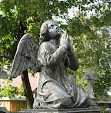 This image is The Valkyrie's Vigil by Edward Robert Hughes. Taken from Wikipedia.org, Valkryie: http://en.wikipedia.org/wiki/Valkyrie
This image is The Valkyrie's Vigil by Edward Robert Hughes. Taken from Wikipedia.org, Valkryie: http://en.wikipedia.org/wiki/ValkyrieI became enchanted with valkyries when I read A Hunger Like No Other by Kresley Cole. I had a vague of flying, robust women in armor, brandishing swords, and wearing horned helmets. I definitely got this mental image from Richard Wagner's opera, The Ride of the Valkyries. In the Kresley Cole Immortals After Dark series, valkyries are known to eat lighting, and to cause it when they become enraged. They are depicted as beautiful, passionate, and very dangerous as enemies. They definitely intrigued my interest. But let's talk a little about the origin of the valkryie in folklore.
According to Wikipedia.org, Valkyries hail from Norse mythology. The etymology is val (slain) and kyrja (choose), literally translating as "choosers of the slain." They are also called shield maidens or disir. Their purpose was to select the most noble of warriors who had died in battle on Odin's behalf. They would carry them off to Valhalla so they could fight at Odin's side in Ragnarok, the battle at the end of the world. They would scour the field of the death to reap the best warriors to take back to Valhalla.
We tend to think of Valkyries as beautiful women, but originally they were quite gruesome and war-like in appearance. Instead of riding winged horse, they rode kennings, or wolves. The valkyries are often represented as carrion-eating ravens, according to the website: The Original Valkyries: A History of the Norse Goddesses.
Valkyries are considered to the be demi-goddesses of death in Norse mythology. In the Prose Edda, the valkyries are said to play a role in human conflict, determining who lives and who dies.
The chief valkyrie is sometimes said to be Freja, the Norse goddess of fertility, love, and beauty, but also battle and death. She has the first choice of the dead warriors to claim as her own.
In Valhalla, the valkyries serve the warriors mead, exchanging their armor for pure white robes. They are also Odin's messengers, known to cause the flickering light phenomena called the Aurora Borealis (Northern Lights.) Thomas Bulfinch notes that the valkyrie's armor causes the flickering light phenomena.
The valkyrie legend is also tied into the legend of swan maidens, who could be captured and held to obtain wishes. As such, valkyries are often called swan maidens or wish maidens.
It is said that any maiden who dies and becomes a valkyrie, will remain immortal as long as she obeys the gods and remains a virgin. In number, they vary from three to sixteen. Some of the names of the Valkryies mentioned in Prose Edda and sagas (minus punctuation) are:
- Brynhildr
- Kara
- Mist
- Sigrune (Victory rune)
- Gunnr
- Hrist
- Svava
- Rota
- Skuld
- Friagabi
It is said that if you see a valkyrie in battle, you will die in that same battle. And valkyries often ride in troops of nine.
If you have an interest in learning more of the valkyries, read the Prose Eddas and Norse mythology, and for a great series based on the valkyries, check out the Immortals After Dark series.
Bibliography
Valkyrie; Wikipedia, The Free Encyclopedia. http://en.wikipedia.org/wiki/Valkyrie. Last modified 4 March 2008. Website accessed 4 March 2008.
The Original Valkyries: A History of the Norse Goddesses.
http://www.dolls-n-daggers.com/Valkyrie.html. Accessed 4 March 2008.


No comments:
Post a Comment